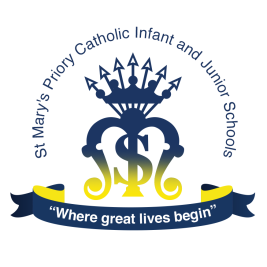Writing
At St Mary’s Priory, we pride ourselves in developing creative, independent and highly-skilled writers. Teachers share excellent models of writing to ensure children understand the importance of writing for a purpose.
Our English sessions are all linked to a core text and this text is carefully chosen to provide meaningful links with the wider curriculum. Children are also exposed to core books that ensure all they are immersed in a range of genres, themes and cultures. Children write for a range of purposes through writing fiction, non-fiction and poetry.
We follow a rigorous writing process that allows children to: plan their writing carefully; orally rehearse their work; consider the audience; use grammar skills effectively. Grammar and punctuation is taught progressively, following the National Curriculum and is brought to life within a range of text types and genres.
Ambitious vocabulary is explored at the start of each teaching unit to allow children to explore new language and apply this in context when writing. Once a piece of writing is completed, the children have the opportunity to edit and improve their work in partners. Once edited they publish their final piece, creating a portfolio of their work to demonstrate progress through their school journey.
Handwriting at St Mary’s Priory
Early Years and Year 1 should be practising and learning the correct letter formations and sizing of upper case and lower case letters on a line. Children will learn to sit correctly at a table, holding a pencil comfortably and correctly. They will understand which letters belong to which handwriting ‘families’ (ie letters that are formed in similar ways) and to practise these.
As they move through to Year 2, children will practise letter formations by introducing joining tails to progress into joined handwriting. They will practise the use of correct spacing between words that reflects the size of the letters. Letters written should be the correct size relative to one another and letters can be clearly identified as tall, short or long letters.
As they move up to Year 3 and throughout Key Stage 2, children will continue to practise joined letter formations ensuring they apply skills taught regarding tall, short and long letters on the line. Children should be joining their handwriting with correct letter size and legibility when writing. They will use the diagonal and horizontal strokes that are needed to join letters and understand which letters, when adjacent to one another, are best left unjoined.
All Key Stage 2 children start the year writing in pencil, and are able to earn a pen licence through hard work and effort.
